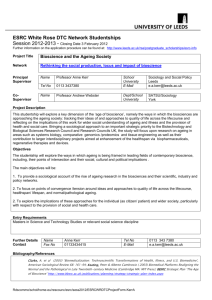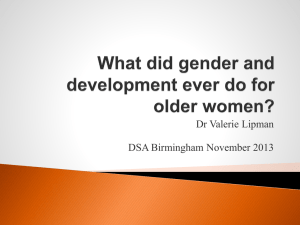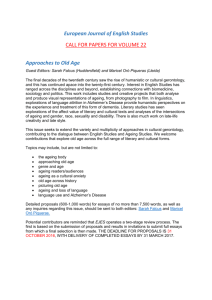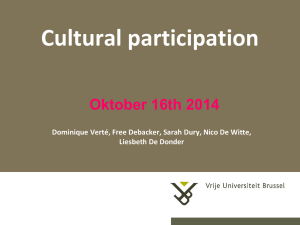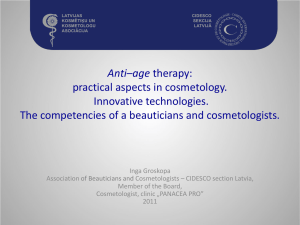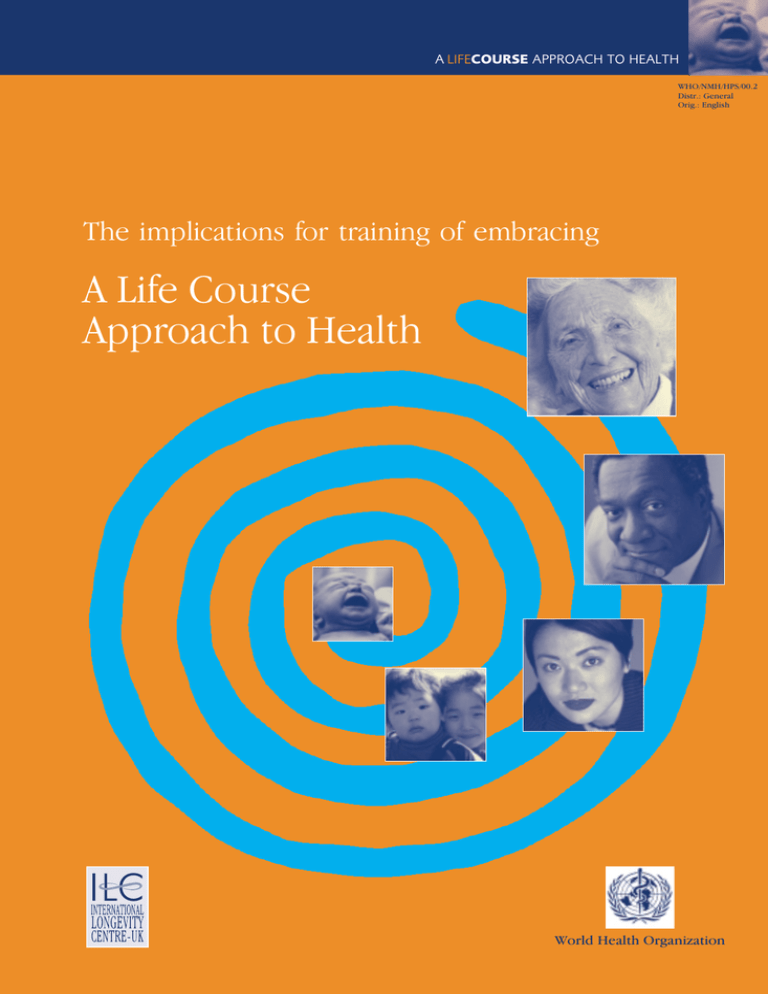
A LIFECOURSE APPROACH TO HEALTH
WHO/NMH/HPS/00.2
Distr.: General
Orig.: English
The implications for training of embracing
A Life Course
Approach to Health
World Health Organization
A LIFECOURSE APPROACH TO HEALTH
Background
This brochure was produced as the result of a workshop organised jointly by the World Health
Organization and the International Longevity Centre-UK, on the initiative of WHO. The brochure
aims to stimulate consideration of the importance and – in practical terms – the effective
realisation of a life-course perspective in the training of health-care professionals. With the
establishment in 1995 of the Ageing and Health Programme (AHE), WHO firmly embraced the ‘life
course’ as one of its key perspectives on ageing, as reflected in its programme activities. In late 1999,
AHE proposed that ILC-UK conduct this joint workshop and invite not only ILC representatives but
also some of the leading life course researchers. We gratefully acknowledge a grant from the
Japanese government to WHO which enabled its realisation.
Population ageing and increasing longevity are necessitating an examination of the skills and training
needs of our health care professionals and the capacity of our health care services and systems.
The meeting organisers believe that the adoption of the ‘life course’ as a conceptual framework will
assist in developing efficient and equitable responses to this challenge.
The brochure is being disseminated to stimulate wider consideration of the issues and ideas
discussed. We are looking to readers – educators and students, – to engage and feedback
with thoughts and ideas on taking forward a life course approach – we want to hear
from you.
©Copyright World Health Organization, 2000
This document is not a formal publication of the World Health Organization (WHO), and all rights are reserved by the Organization.
The document may, however, be freely reviewed, abstracted, reproduced and translated, in part or in whole, but not for sale nor for
use in conjunction with commercial purposes. The views expressed in documents by named authors are solely the responsibility of those authors.
PAGETWO
A LIFECOURSE APPROACH TO HEALTH
Why promote the life course?
The importance of the life course as a framework is often downplayed as ‘common sense’ and its
promotion ‘needless’. In reality however, acceptance of this principle has enormous implications on
the way an individual’s health is considered, for the training of health care professionals and for the
way health systems are developed to cater for individuals’ health care needs. Epidemiological
research is beginning, and will continue, to enhance our understanding of the relative importance of
different stages in the life course in relation to health capital and specific disease processes. Findings
will enable the development and fine-tuning of life course models with specific implications for
health and social policy interventions. In the meantime, as will be shown, there is value to be gained
in acknowledging the importance of adopting a life course approach to health, exploring the issues
raised and addressing the challenges that result.
In the education and training of health-care professionals, a life course approach offers the potential
to enhance the integration of teaching and to prepare students, across both the developed and
developing worlds, for carrying out their responsibilities in the twenty-first century.
Population of regions of the world
Population (in billions)
2000
2025
2050
6.055
7.824
8.909
More developed countries
1.188
1.215
1.155
Less developed countries
4.867
6.609
7.754
0.419
0.817
1.458
More developed countries
0.171
0.254
0.299
Less developed countries
0.248
0.563
1.159
Total
Age >65 years
Total
Source: United Nations. World Population Prospects: The 1998 Revision. (Medium Variant Projections)
PAGETHREE
A LIFECOURSE APPROACH TO HEALTH
A life course approach to health
A life course approach emphasises a temporal and social perspective, looking back across an
individual’s or a cohort’s life experiences or across generations for clues to current patterns of health
and disease, whilst recognising that both past and present experiences are shaped by the wider
social, economic and cultural context. In epidemiology, a life course approach is being used to study
the physical and social hazards during gestation, childhood, adolescence, young adulthood
and midlife that affect chronic disease risk and health outcomes in later life. It aims to identify the
underlying biological, behavioural and psychosocial processes that operate across the life
span (Kuh and Ben-Shlomo, 1997).
A life course approach incorporates, but is broader than, ‘the fetal origins hypothesis’ (programming)
which links conditions in the intrauterine environment to the later development of adult chronic
disease (Barker, 1998). Growing evidence suggests that there are critical periods of growth and
development, not just in utero and early infancy but also during childhood and adolescence, when
environmental exposures do more damage to health and long-term health potential than they would
at other times. There is also evidence of sensitive developmental stages in childhood and
adolescence when social and cognitive skills, habits, coping strategies, attitudes and values are more
easily acquired than at later ages. These abilities and skills strongly influence life course trajectories
with implications for health in later life. Additionally, a life course approach considers the long term
health consequences of biological and social experiences in early and mid adulthood, and whether
these factors simply add additional risk or act interactively with early life biological and social factors,
to attenuate or exacerbate long term risks to health.
Cumulative effects on later health may occur not only across an individual’s life but also across
generations (Lumey 1998; Davey Smith 2000). Many animal studies have highlighted the
perpetuation of both size at birth and subsequent growth across generations; this may have
important nutritional implications especially in the developing world. Further research will assist
assessment of how and when to optimally target interventions to cost-effectively improve health.
Socio-economic conditions throughout the life course shape adult health and disease risk. This is
because health-damaging exposures or health-enhancing opportunities are socially patterned, and
because an individual’s response, which may modify their impact or alter the risk of future exposures,
will be powerfully affected by their social and economic experience (Kuh et al, 1997). The strength of
the relationships between adult disease and socio-economic circumstances at different life stages can
thus provide clues to the underlying aetiological processes (Davey Smith et al, 1998 ). A life course
approach is being used in research on social inequalities in health, to investigate how experiences
PAGEFOUR
A LIFECOURSE APPROACH TO HEALTH
and exposures at different life stages accumulate and create the social inequalities in morbidity and
mortality observed in middle and old age (Davey Smith, 2000; Leon, 2000).
A life course approach to adult health is not a new concept – the idea that experiences in earlier life
shape adult health, was the prevailing model of public health in the first half of the twentieth century.
In the post war period the dominance of the adult life style model for adult chronic disease was due to
the early success of cohort studies in confirming, for example, smoking as a major risk factor for lung
cancer, coronary heart disease and respiratory disease, and hypertension as important for stroke and
IHD. However, conventional risk factors are limited in predicting individual risk and only partially
explain the striking social and geographical inequalities in the distribution of chronic disease. Since
the 1980s, there has been a revival of interest in life course epidemiology in response to growing
empirical evidence from the maturing birth cohort studies and the revitalisation of historical cohorts.
Conceptual models of the life course
The simplest classification groups conceptual models of the life course under 4 headings:
1 A critical period model
2 A critical period model with later effect modifiers
3 Accumulation of risk with independent and uncorrelated insults
4 Accumulation of risk with correlated insults (clustering, chains or pathways of risk)
There is evidence for all four models. A critical period model is when an insult during a specific
period of development has lasting or lifelong effects on the structure or function of organs, tissues
and body systems. Evidence suggests that later life factors may modify this early risk (model 2).
For example, studies have shown that the relationships of coronary heart disease, high blood
pressure and insulin resistance with low birth weight are particularly strong for those who are
overweight (see figure) (Frankel et al, 1996; Lithell et al 1996; Leon et al, 1996).
In contrast, the gradual accumulation of risk models encourage researchers to study how risk factors
at each life stage combine to raise disease risk. Do separate and independent insults gradually cause
long-term damage to health (model 3)?
Risk factors tend to cluster in socially patterned ways, for example, those living in adverse childhood
social circumstances are more likely to be of low birth weight, and be exposed to poor diet, childhood
infections and passive smoking. These exposures may raise the risk of adult respiratory disease,
perhaps through chains of risk or pathways over time where one adverse (or protective) experience
will tend to lead to another adverse (protective) experience in a cumulative way (model 4). As well as
the biological chains of risk linked with programming, there are social chains of risk where, for
PAGEFIVE
A LIFECOURSE APPROACH TO HEALTH
example, repeated respiratory disease in childhood may result in increased sick absence from school
and lower educational attainment, which in turn leads to a greater likelihood of smoking in
adulthood and a manual occupation with greater respiratory hazards.
CHD Incidence by Birthweight and BMI: The Caerphilly Study
1st birthweight tertile
2nd birthweight tertile
3rd birthweight tertile
p=0.5
p=0.0005
Percent
18
16
14
12
10
8
6
4
2
0
p=0.5
1
2
BMI TERTILE
3
Source: Frankel et al (1996) Birth weight, Body Mass Index in middle age and incidence of coronary
heart disease 348: 1478-80 © by The Lancet Ltd. 1996
Conclusion
We are only starting to disentangle the influence of early life factors relative to genetic and later life
factors on adult health and ageing: explanations may be cohort and disease specific; factors may be
additive or interact synergistically. Caution is required in extrapolating from the past to the present
and from one place to another. However, the questions being raised are fundamental. A life course
approach provides an essentially optimistic approach to health and raises questions for policy. It
helps identify chains of risk that can be broken and times of intervention that may be especially
effective. Particularly during key life transitions, e.g. late adolescence to early adulthood, we need to
provide not just safety nets but springboards (Bartley et al 1997), which can alter life course
trajectories with implications for subsequent health.
The advantages of using a life course model to study adult health is that it is interdisciplinary and
integrates social and biological explanations. It also allows synthesis of other models of health
and chronic disease such as the foetal origins and adult lifestyle models.
PAGESIX
A LIFECOURSE APPROACH TO HEALTH
Functional capacity and the life course
Functional capacity
A life course perspective for maintenance of the highest possible level
of functional capacity
Early Life
Adult Life
Older Life
Growth and
development
Maintaining highest
possible level of function
Preventing disability and
maintaining independence
Range
of
in indiv function
iduals
Disability threshold
Environmental changes
can lower the
disability threshold
Rehabilitation and ensuring
quality of life
Age
Source: WHO/HPS, Geneva 2000
Ageing is a life-long process – the above conceptual framework has been developed by WHO to
capture this. Functional capacity (such as ventilatory capacity, muscular strength, cardio-vascular
output) increases in childhood and peaks in early adulthood, eventually followed by a decline.
The rate of decline, however, is largely determined by factors related to adult life style – such as
smoking, alcohol consumption, levels of physical activity and diet. The gradient of decline may
become so steep as to result in premature disability. However, the acceleration in decline may be
reversible at any age and can be influenced at any age through individual as well as policy measures.
Smoking cessation and small increases in the level of physical fitness, for example, reduce the risk of
developing coronary heart disease. Conditioning by social class also affects functional capacity.
Poor education, poverty, and harmful living and working conditions all make reduced functional
capacity more likely in later life.
For those who become disabled, provision of rehabilitation, adaptations of the physical environment
and specific interventions e.g. cataract surgery, can greatly reduce the level of disability – the
disability threshold can be lowered. Quality of life should be a major consideration throughout the
life course; changes in living environment can vastly improve quality of life. Gains are obtained by
PAGESEVEN
A LIFECOURSE APPROACH TO HEALTH
acting on the ‘care unit’ – in most case the family and close friends. Through appropriate
environmental changes such as adequate public transport in urban environments, lifts, ramps, and
adaptations in the home – the disability threshold can be lowered. Such changes can ensure a more
independent life well into very old age.
Implications for training
The following issues were raised and ideas put forward at the workshop. If you have contributions
to make to the debate or practical suggestions on taking forward a life course approach – we want to
hear from you – visit www.ilcuk.org.uk or e-mail us at lifecourse@ilcuk.org.uk
In the experience of participants, the life course is not ‘explicitly’ and rarely implicitly used as a
framework within education. In addition, the teaching of geriatrics in some schools in developed as
well as in developing countries, is limited, resulting in an incomplete presentation of the life course.
Given the reality of our ageing populations, it is clear this situation is untenable. We would stress the
relevance of the following to the training of health care professionals in general.
What does a ‘life course’ approach offer?
A curriculum framework which:
●
Stresses the importance of all ages and stages of life and acknowledges the
intergenerational context within which individuals exist.
●
Recognises the temporal dimension of health and ageing, rather than just distinct episodes
of illness; personalises and humanises ill health as part of a life process.
●
Offers the opportunity to focus on ‘health’ as well as specific disease processes; in terms of
disease, it emphasises health promotion, disease prevention and cure and disease management
throughout life (can assist in ensuring a balance in teaching).
●
Emphasises primary interventions in addition to cure or palliation.
●
Is interdisciplinary – offering the potential to link together current ‘islands’ of teaching,
particularly in social and psychosocial topics.
●
Integrates the progression from cellular to organ-based to organism and population level
information.
●
Requires a multidisciplinary approach from staff that should improve overall co-ordination of
teaching.
●
Is ‘novel’ – it represents an exciting area of current research and may promote an enquiry
based learning approach.
PAGEEIGHT
A LIFECOURSE APPROACH TO HEALTH
●
Reflects the already existing model of primary health care; it offers a framework for the
geriatric training of GPs (especially relevant to developing countries) and other specialists.
●
Offers inspiration to developing countries which are ‘ageing in poverty’ as a force for change –
sets goals of investment in health capital through health promotion and prevention.
Cobweb of life course in medical education
Embryology
Development
psychology
Geriatrics
Public Health &
epidemiology
Paediatrics
Medical
sociology
Life course
Neuroendocrinology
Community
medicine
What are the challenges facing its adoption?
●
The clinical imperative to ‘save lives’ and in many instances, act in the short term.
●
The constraints of the health system into which trainees are ‘delivered’.
●
The complexity of health and disease highlighted by the life course perspective.
●
The current division into pre-clinical and clinical courses and teaching and the adoption by most
schools of a curriculum with a modular structure, which may lack meaningful horizontal-vertical
integration.
●
School curricula are ‘over-full’ and time is limited; there will inevitably be logistical and attitudinal
resistance to change – from both staff and students.
●
The inter- and intra-national diversity in school philosophies, teaching methodologies, and
curricula, often independently set.
How can these challenges be addressed?
Those promoting a life course approach need to:
●
Emphasise that a life course approach changes the process of curriculum delivery, rather
than the content.
●
Develop examples, pilot models and educational resources to assist conceptualisation and
ease implementation – ‘market’ the approach; ensure adaptability and sensitivity to different
teaching methodologies and cultures.
PAGENINE
A LIFECOURSE APPROACH TO HEALTH
Clinical domains & the life course
●
Aetiology – clues to mechanisms; links the social to the biological and vice-versa.
●
Diagnosis – modes of presentation and lay epidemiology.
●
Prognosis – functional reserve and response to disease
●
Treatment – limited impact for tertiary prevention as mainly primary prevention; may be
important in understanding non-compliance.
●
Encourage the early development and integration of a life course perspective into the teaching of
public health.
●
Promote the life course approach beyond the undergraduate curriculum to advanced training
and the clinical environment.
●
Recommend a life course approach be adopted in the training of all health care workers.
●
Encourage lessons to be drawn from existing holistic/ interdisciplinary approaches utilised in
geriatric training and also encourage geriatric programmes to adopt a ‘reverse’ life course
approach, focusing on healthy ageing as well as specific disease processes.
●
Note the critical importance of staff recruitment and on-going development in
implementing this approach.
●
Develop steps and strategies for implementation that involve national bodies, school boards,
political influencers and general public awareness; ‘lead by example’ and ‘sell’ the approach
through facilitating top-down acceptance.
●
Encourage the review of admission criteria for medical schools to consider the social context
of health; allow greater opportunity for older individuals with more personal life course experience
to train in medicine (also recognising increasing life-expectancy and later retirement patterns).
Cause of death in developing countries
9%
11%
19%
41%
Non-communicable 8
diseases8
50%
70%
1990
PAGETEN
Communicable 8
diseases8
2020
External causes
Source: Murray C. and Lopez A.
The Global Burden of Disease, 1996: OUP
A LIFECOURSE APPROACH TO HEALTH
Taking forward a life course approach
Workshop participants agreed to explore different ways of taking forward this approach, liasing both
with local partners and internationally to generate resources and momentum. Suggested initiatives
include the development of adaptable curriculum and course materials, considering issues of
curriculum integration, impact and change; production of publications on the life course perspective
focusing on implications for specific health or medical areas; using national and international
conferences as platforms for dissemination of life course ideas; lobbying to improve the positioning
of population ageing and health on the development agenda – international aid agencies, donors and
NGOs are still overwhelmingly focused on children; encouraging the development of ‘community
friendly’ or ‘life course friendly’ i.e. ‘people friendly!’ health centres, especially relevant to developing
countries. We are committed to working with professional and health care networks to maximise
dissemination of information, initiatives and ideas. Concrete recommendations on realising a life
course approach to health will be developed to feed into the World Assembly on Ageing in 2002.
Do you have practical suggestions for taking forward the ideas expressed? Have you been inspired
by the use of a life course framework during your education? Have you utilised the life course as a
framework in your teaching? Would you promote a life course approach?
Share your ideas – visit www.ilcuk.org.uk or email us at lifecourse@ilcuk.org.uk
To those of you for whom this approach does not ‘feel’ new – we are looking to learn from your
experience and practical ideas on how to make it more explicit. To others who feel this approach is
missing – we need to hear this expressed! The web-site will be developed to incorporate your
thoughts and link to and promote new initiatives as they emerge. Make it YOURS! We look
forward to hearing from you.
Limited copies of the brochure and an A2 poster publicising the web-site www.ilcuk.org.uk
(contains an electronic copy of the brochure, also in French and Spanish) are available – contact
activeageing@who.int for copies. All text references in full, further information and links are also
available on the web-site.
Resources
A Life-course Approach to Chronic Disease Epidemiology eds. Diana Kuh and Yoav Ben-Shlomo
(Oxford University Press, 1997) ISBN 0 19 2627821.
A life-course perspective of maintaining independence in older age (WHO, 1999)
WHO/HSC/AHE/99.2; contact activeageing@who.int for copies.
PAGEELEVEN
A LIFECOURSE APPROACH TO HEALTH
Participants – life course working group
Vijay Rawal (EMSA) European Medical Students Association; Mats Sundberg, Jacco Veldhuyzen, Robert C van de Graff
(IFMSA) International Federation of Medical Students’ Associations; Baroness Greengross, Charles Carter,
Jo Winterburn International Longevity Centre – United Kingdom; Dr. Mireille Kingma International Council of
Nurses; Professor Francoise Forette M.D. International Longevity Centre – France; Dr. Susan Morton London School
of Hygiene and Tropical Medicine, UK; Gerald Bennet M.D. Mile End Hospital, UK – Department for Health
Care of the Elderly; Harrison G. Bloom M.D. (ILC-USA Associate) Mount Sinai Medical Centre, U.S.A. –
Department of Geriatrics & Adult Development; Dr. Martha Pelaez Pan American Health Organisation –
Regional Advisor, Ageing and Health; Dr. Diana Kuh Royal Free & UCL Medical School, UK – MRC National
Survey of Health & Development; Professor Antony de Bono M.D. UN International Institute on Ageing – Malta;
Dr Yoav Ben-Shlomo University of Bristol, UK – Department of Social Medicine; Professor Shah Ebrahim M.D.
University of Bristol, UK – Department of Social Medicine; Dr Alexandre Kalache, Ingrid Keller World Health
Organization – NMH/HPS.
Appreciation is expressed to all workshop participants for their contributions, particularly to Dr. Yoav Ben-Shlomo
The ILC-UK believes that population ageing and the longevity revolution necessitate dramatic changes in attitudes and
approaches to the life course, at both societal and individual levels. The organisation is part of a multinational consortium
of International Longevity Centres whose mission is to help societies address longevity and population aging in positive
and productive ways. For further information contact:
International Longevity Centre – UK
Walkden House,10 Melton Street, London NW1 2EB
Tel. +44 20 8765 7817 Fax +44 20 8765 7873
enquiries@ilcuk.org.uk
www.ilcuk.org.uk
The WHO Ageing and Health Programme was established in 1995, building on the achievements of its predecessor,
the Programme on Health of the Elderly. This change in title acknowledged the importance of a life-course
perspective; life as a continuum, ‘ageing’ rather than ‘the elderly’. In March 2000 a major restructuring took place in
WHO, leading to the establishment of a new Department (Health Promotion/Non-communicable Diseases Prevention
and Surveillance) in which ‘Ageing and Health’ is mainstreamed through its four units: Life Course and Health;
Legislative and Economic Policies; Community-Based Prevention Approaches; and Risk Factor Surveillance.
World Health Organization
Non-Communicable Disease and Mental Health Cluster
Health Promotion, Non-Communicable Disease Prevention and Surveillance Department
1211 Geneva 27 Switzerland
Tel: +41 22 791 3405 Fax. +41 22 791 4839
activeageing@who.int
www.who.int/ageing
Designed and Printed by: Voluntary Sector Services, Centurion Press Limited, Rickmansworth, Hertfordshire.
and Dr. Diana Kuh.



